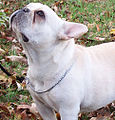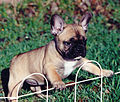French Bulldog Coat Colors – or lack thereof
/5 Comments/in French Bulldog Stuff /by frogdogzI thought I’d write a second part to my article on French Bulldog coat colors, since it gives me a chance to get a terrible burden off of my chest –
I’ve been perpetuating a lie.
Yes, it’s true. All over the web, you’ll find sites parroting this line, from my initial article on coat colors and the French Bulldog FAQ –
“French Bulldogs come in a myriad of colors”
This is, I’m afraid, completely untrue. French Bulldogs, in actual fact, only come in one single coat color – the Golden Sabel/Dominant yellow of the Agouti or ‘A’ series. It’s carried as ay. Everything else we see, from brindle pied to fawn pied to ‘tiger’ brindle to blue fawn to ‘white’, is not a color, but a marking pattern, overlaying or somehow modifying that base coat color of Golden Sable.
It’s true. The genetic ‘base color’ of the French Bulldog is golden sable – think deep golden cream. All of the varying shades and colors in between – from vivid reds to pale buttery yellows to black tipped sable, are just variations on this initial color, thanks to modifiers such as the E Extension series or D Dilute series. It’s theorized that so called ‘blue’ or ‘mouse’ French Bulldogs are a result of the D series dilute gene (dd), but this is just conjecture.
While French Bulldogs might not have a wide variety of colors, what we do indeed have is a staggeringly large variety of marking patterns and modifiers to change the appearance of this one color. The basic patterns are –
Brindle, then, is a pattern of black stripes of varying thickness and degree of repetition, overlaying this base golden color.
Pied is a pattern of white markings interspersed with either self colored areas (fawn pied) or brindled areas (brindle pieds)
Heavily marked brindle or fawn dogs, which seem to sit on the fence between dogs with white markings, and pieds, are likely dogs carrying the si or Irish Spotting allele of the S series.
Black masked dogs are dogs of whichever color/pattern, carrying the black masking gene.
Of course, since Frenchies are Frenchies, and nothing can ever be simple in this breed, we have to deal with the appearance of Liver colored dogs, as well as those of Black and Tans. Both patterns are beyond my scope, or that of my outdated “Genetics of the Dog’ reference book, to explain, but I’m sure someone out there can give us a possible explanation for their occasional appearance.
All of what we know about French Bulldog coat color genetics is currently up in the air. Old theories are being overturned, new ones posited, and differences of opinion over the placement and indeed actions of the various alleles are apparently now commonplace.
What’s heartening is that new genetic testing is becoming available which will soon allow us to run a simple test and determine what color and patterns our dogs are without having to rely on the subjective appearance a dog seems to be – something that no two breeders can ever seem to agree on.
Perhaps soon, when asked what ‘color’ my dog is, I can reply by handing you a copy of his genetic blueprint. It would sure save a lot of arguing!
Coat Colors? – Them's fightin' words!
/7 Comments/in French Bulldog Stuff /by frogdogzWant to start a fight on a French Bulldog discussion list? Bring up the topic of French Bulldog coat colors. There are few other topics more guaranteed to get threads going of 75 or more responses, or more promising of exchanges like ‘oh yeah? Sez you’ and ‘You wouldn’t know medelian genetics if it jumped up and bit you in the face’.
There’s a fairly simple reason for this, actually – complexity. Few if any breeds come in the staggering array of allowable colors and patterns seen in French Bulldogs. Our standard in North America pretty much states ‘except for these few disallowed colors, have at it, dog breeders!’. To be more precise, the American Kennel Club standard for the French Bulldog says –
Acceptable colors – All brindle, fawn, white, brindle and white, and any color except those which constitute disqualification. All colors are acceptable with the exception of solid black, mouse, liver, black and tan, black and white, and white with black, which are disqualifications. Black means black without a trace of brindle.
Read that again, carefully –
any color except those which constitute disqualification
That means that if I can genetically engineer myself a glow in the dark pink Frenchie, I could register and show it.
Night shows would be particularly interesting to show one at, don’t you think?
The European standards are a bit tougher on colors, with the FCI standard stating –
– Uniformly fawn, brindled or not , or with limited patching (pied).
– Brindled fawn or not, with medium or large patching.All the fawn shades are admitted, from the red to light brown (café au lait) colour. The entirely white dogs are classified in “brindled fawn with large white patching”. When a dog has a very dark nose, dark eyes with dark eyelids, certain depigmentations of the face may exceptionally be tolerated in very beautiful subjects.
The FCI standard doesn’t need to list specific DQs (or disqualifications), as their standard has a short, concise list of allowable colors, instead. So, rather than the American standard, which tells us ‘anything other than these few colors is allowed’, the FCI standard says ‘nothing other than these few colors is allowed’.
Over in the UK, the standard says –
Brindle, pied or fawn. Tan, mouse and grey/blue highly undesirable.
Brindle: a mixture of black and coloured hairs. May contain white provided brindle predominates.
Pied: white predominates over brindle. Whites are classified with pieds for show purposes; but their eyelashes and eye rims should be black. In pieds the white should be clear with definite brindle patches and no ticking or black spots.
Fawn: may contain brindle hairs but must have black eye lashes and eye rims.
Reading this, one would assume that ‘cream’, as an ee expression of fawn, would be allowed. One would, however, be wrong. The British French Bulldog breeders are almost completely uniform in their rejection of anything other than what we refer to as ‘Black Masked Fawn’ – those smutty, tan colored dogs, with the clear black masks. Even the masked red fawns and red fawn pieds are still rejected. In fact, the predominance of the red fawn pied dogs we see in North America can be traced to a handful of UK dogs exported to the US, dogs which were sold mainly because their color was not showable in the UK.
These ‘DQs’ might not be specified in the standard, but they are still accepted as the norm – and if I’m wrong about this, and attitudes are changing, I’d love to hear about it.
The issue of cream versus fawn versus black masked fawn is of particular interest to most North American French Bulldog breeders, where the exact method of inheritance is still open to debate. I’ll discuss further on the vagaries of coat color genetics another time.
For now, I’ll leave you with the color example chart I created for Wikipedia, and which you can also find on French Bulldog Z. As I state repeatedly on both sites, these photos and their corresponding color descriptions are listed as examples only, and are open to debate. The only truism when it comes to French Bulldog coat colors is there are more descriptive color names than there are colors, and everyone has their own preference.
It should also be pointed out that some color terms are subjective, with each breeder having their own opinion as to what defines ‘fawn pied’, ‘honey pied’, etc. The examples listed below should be viewed objectively, and are open to debate. In other words, don’t bother sending me snippy letters if you disagree with my descriptions, as I already have a file of about 200 of those. Polite debate, however, is welcomed.
Click thumbnails to see full sized images.
|
|
|
|
|
|
|
|
|
|
|
|
|
|
|
|
|
|
|
|
|
|
|
|
|
|
|
|
|
|
|
|
|
|
|
|
|
|
|
|
|
|
|
|
|
|
|
|
|
|
|
|
|
|
|
|
|
|
|
|
|
|
|
|
|
|
Missing French Bulldogs Near Chandler, Oklahoma
/3 Comments/in French Bulldog Stuff /by frogdogzOur friend Pat Pearce, one of the writers for our Ask the Experts column, has suffered a horrible tragedy. Two of her French Bulldogs have escaped from her fenced yard near Chandler, Oklahoma.
If you’re in the area, please be on the look out, and please consider cross posting this notice.
Here’s Pat’s email, and at the end you’ll find a link to a downloadable PDF file that can be handed out at vet clinics or posted in other areas where they might be seen.
I need help finding my pups… I have this written up… and have attached photos and a flyer that I am asking folks to get to their local vets and shelters.. and of course permissing is given to cross post far and wide.. and can you post it on your site”
Two of my dogs escaped from my fenced yard and are lost. I live outside Chandler, OK. I have done all the things – flyers everywhere, talked to all the neighbors, the mail man, the police, ads in the local paper, etc…all with NO results. They have not been seen since a very short time after they escaped. I fear that someone has picked them up.
They are Robin, 18 month old brindle girl and Hunter, 14 month honey pied male, both are micro chipped… I can be reached at my cell phone 405-650-4051 or by email at Fidoknows@gmail.com One has a condition and needs constant medication…
Pat

















